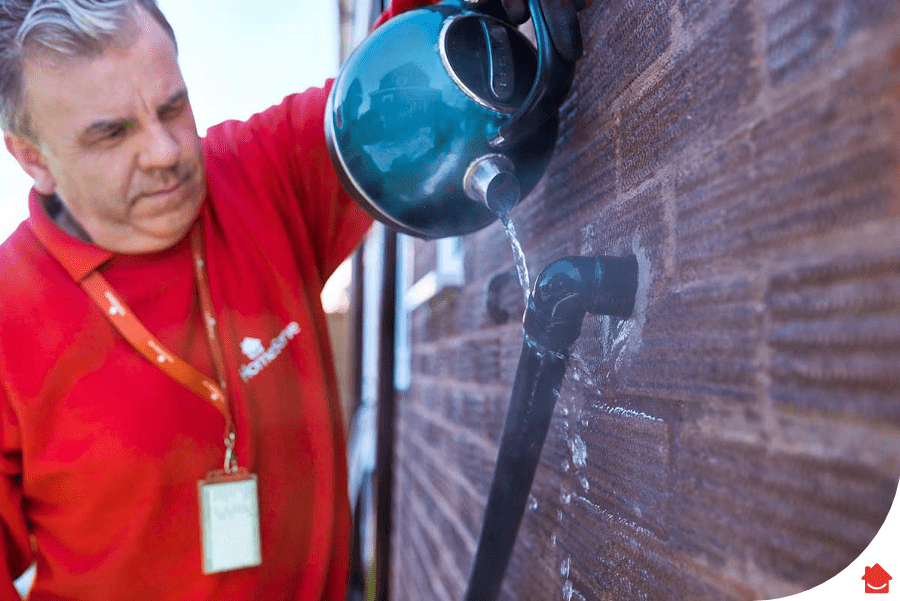Understanding your boiler
Boiler condensate pipe regulations explained
22 Sept 2021 • 5 minutes

Understanding your boiler
22 Sept 2021 • 5 minutes

If you’re a homeowner or landlord, you might be thinking ‘Why on earth do I need to know about boiler condensate pipe regulations?’ The reason is because incorrectly installed boiler condensate pipes have been the source of a disproportionate volume of boiler breakdowns over the last 10 years.
If you have a condensing boiler, then it’s a good idea to know if your condensate pipe has been installed in line with current regulations, so it doesn’t freeze in winter and stop your boiler in its tracks. This guide will tell you all you need to know to avoid a breakdown.
In April 2005, building regulations were revised to state that all new oil or gas boilers needed to be condensing boilers, in an effort to reduce the UK’s carbon footprint. It meant that only highly efficient condensing boilers could be installed from that moment on, and this has been a significant breakthrough in reducing the country’s carbon footprint.
Since 2005, weather trends like extended periods of frost have caused an increase in condensing gas boiler breakdowns. These breakdowns happen when the condensate discharge pipe freezes, resulting in homeowners having to thaw their condensate pipe.
A condensing boiler is any boiler that uses condensing technology to reuse the heat they generate from burning fuels such as gas or oil.
Before 2005, older, non-condensing boilers wasted between 30-50% of heat due to combustion gases escaping via the flue. A condensing boiler, in comparison, can be up to 92% efficient.
This is because in a condensing boiler, the latent heat flue gases can be repurposed and reused to preheat the cold water coming into the boiler. During this process, the temperature of the flue gas is rapidly reduced from around 130℃ to 90℃.
As the gases cool, condensation is produced. A condensing boiler will produce about 2 litres of condensate an hour at an average temperature of 30-40℃. This condensate needs to drain into your waste water outlet or to a drain via your condensate pipe.
A combi boiler can also be a condensing boiler. If your boiler was installed after 2005, then it’s 99% probable that it’s a condensing boiler because of the regulations.
So, back to the issue at hand. In the majority of boiler breakdowns caused by the condensate pipe freezing, the condensate discharge pipe has been fitted externally to the property. This can be for just some of its length or all of it.
This external fitting exposes the pipe to extreme winter temperatures and directly influences whether it freezes and causes the boiler breakdown or not.
For this reason, the UK’s Heating and Hot Water Industry Council (HHIC) has published guidance on condensate pipes for installers, pointing to the current British Standard BS6798, which states that ‘wherever possible, the condensate drainage pipe shall be terminated at an internal foul water discharge point’.
They add that: ‘Where there is no other option than to run the pipe externally, the pipe needs to be increased to at least a 30 mm inside diameter and insulated to help prevent freezing.”
If you need to thaw a condensate pipe, follow our step-by-step guide to help you get your boiler up and running quickly and easily. If this doesn’t help and you’re still having problems, get in touch with us and we’ll be happy to help.
It’s a really good idea to know where your boiler’s condensate pipe discharges to. If it’s an external pipe, then if it’s not the recommended internal diameter and adequately insulated, you could be running the risk of your condensing boiler freezing up and conking out this winter.
If you’re about to buy a new condensing boiler or you’re renovating a kitchen or a whole property. It’s important to be aware of this. So let’s look at the HHIC’s guidance in more detail.
The HHIC states that: ‘Where an installer is fitting a new or replacement boiler, the condensate discharge pipe should be connected to an internal ‘gravity discharge point’, such as an internal soil stack (preferred method), internal kitchen or bathroom waste pipe such as sink, basin, bath or shower waste.
External pipes from sink wastes or washing machine outlets should be:
We’re now working together with BOXT to help you take better care of your home; combining over 30 years experience in home assistance with one of the largest boiler installation companies in the UK.
With over 150,000 happy customers, 22,000 5 star Trustpilot reviews and as well as a range of finance options the experts at BOXT will help you get the best boiler for your home and budget. Get a fixed price quote from BOXT now.
The HHIC states that:
“When fitting a new or replacement boiler, the condensate discharge pipe should be connected to an internal ‘gravity discharge point’, such as an internal soil stack, internal kitchen or bathroom waste pipe such as sink, basin, bath or shower waste. Where there’s no other option than to run the pipe externally, the pipe needs to be increased to at least a 30 mm inside diameter and insulated to help prevent freezing.”
A condensing boiler will produce about 2 litres of condensate an hour at an average temperature of 30-40℃. This condensate needs to drain into your waste water outlet or to a drain via your condensate pipe.
Our help & advice articles cover Plumbing, Home heating, Electrical, Energy-saving and Home maintenance.